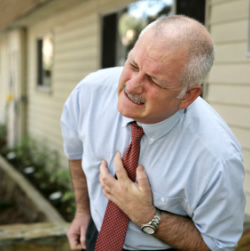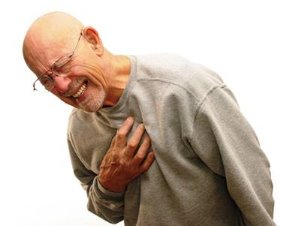Heart Attack Symptoms - Warning Signs of a Heart Attack
The term " heart attack" is often used to refer to signs and symptoms that result from the sudden blockage of blood flow to a portion of the heart. A blockage in the heart’s arteries may reduce or completely cut off the blood supply to a portion of the heart. This can cause a blood clot to form and totally stop blood flow in a coronary artery, resulting in a heart attack (also called an acute myocardial infarction or MI). Without good blood flow, the heart does not receive enough oxygen and begins to die.
Heart Attack Symptoms & Warning Signals
 People suffering from a heart attack may experience symptoms such as chest pain, sweating, nausea, weakness, and shortness of breath. Each year about 1.5 million Americans have heart attacks. Heart disease remains the leading cause of death in the United States for both men and women.
People suffering from a heart attack may experience symptoms such as chest pain, sweating, nausea, weakness, and shortness of breath. Each year about 1.5 million Americans have heart attacks. Heart disease remains the leading cause of death in the United States for both men and women.
Heart attack is the common term for a "myocardial infarction." This refers to the permanent damage done to the heart muscle, or myocardium when blood flow is blocked. A heart attack most commonly happens when a blood vessel that brings blood to the heart is suddenly blocked by a blood clot.
While heart attacks usually come on suddenly, it’s really the result of a process that takes years to develop. Over time, a person’s blood vessels may become hardened and narrowed by the buildup of cholesterol and other fatty substances. Reducing risk factors for coronary artery diseases such as high cholesterol or high blood pressure is an important way to prevent a first or subsequent heart attack.
A heart attack usually occurs over several hours. Fast action is the best weapon against a heart attack. If a person is treated during the first two hours after a heart attack, early treatments can improve outcomes. The coronary arteries supply the heart muscle with oxygen and nutrients. Coronary artery disease (CAD) is the most common form of heart disease. Coronary heart disease develops when one or more of the coronary arteries that supply the blood to the heart become narrower than they used to be, due to the buildup of cholesterol and other substances in the wall of the artery, affecting the blood flow to the heart muscle. Without an adequate blood supply, heart muscle tissue can be damaged.
Deposits of cholesterol and other fat-like substances can build up in the inner lining of these blood vessels and become coated with scar tissue, forming a cholesterol-rich bump in the blood vessel wall known as plaque. Plaque buildup narrows and hardens the blood vessel, a process called atherosclerosis, or hardening of the arteries.
Warning Signs of a Heart Attack
 The American Heart Association and other medical experts say the body likely will send one or more of these warning signals (symptoms) of a heart attack:
The American Heart Association and other medical experts say the body likely will send one or more of these warning signals (symptoms) of a heart attack:
- Uncomfortable pressure, fullness, squeezing, or pain in the center of the chest lasting more than a few minutes.
- Pain spreads to the shoulders, neck, or arms. The pain may be mild to intense. It may feel like pressure, tightness, burning, or heavy weight. It may be located in the chest, upper abdomen, neck, jaw, or inside the arms or shoulders.
- Chest discomfort with lightheadedness, fainting, sweating, nausea, or shortness of breath.
- Anxiety, nervousness, and/or cold, sweaty skin.
- Paleness or pallor.
- Increased or irregular heart rate.
- Feeling of impending doom.
Note: Not all of these warning signs and symptoms occur in every heart attack. Sometimes they go away and return. If some occur, get help fast. If you notice one or more of these signs in yourself or others, don’t wait. Call emergency medical services (911) right away! In the event of cardiopulmonary arrest (no breathing or pulse), call 911 and begin cardiopulmonary resuscitation (CPR) immediately.